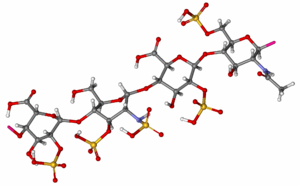 | |
 | |
| Clinical data | |
|---|---|
| Trade names | Lovenox, Clexane, Xaparin, others |
| Biosimilars | Arovi, Axberi,[1] Axberi HP,[1] Exarane,[2] Exarane Forte,[2] Enoxapo,[3] Inclunox, Inclunox HP, Inhixa, Noromby, Noromby HP, Redesca, Redesca HP, Thorinane |
| AHFS/Drugs.com | Monograph |
| MedlinePlus | a696006 |
| License data |
|
| Pregnancy category | |
| Routes of administration | Subcutaneous, intravenous |
| ATC code | |
| Legal status | |
| Legal status | |
| Pharmacokinetic data | |
| Elimination half-life | 4.5 hours |
| Identifiers | |
| CAS Number | |
| PubChem CID | |
| IUPHAR/BPS | |
| DrugBank | |
| ChemSpider |
|
| UNII | |
| KEGG | |
| ChEMBL | |
| CompTox Dashboard (EPA) | |
| ECHA InfoCard | 100.029.698 |
| Chemical and physical data | |
| Formula | (C26H40N2O36S5)n |
| Molar mass | 4500 g/mol (average) |
| | |
Enoxaparin sodium, sold under the brand name Lovenox among others, is an anticoagulant medication (blood thinner).[11] It is used to treat and prevent deep vein thrombosis (DVT) and pulmonary embolism (PE) including during pregnancy and following certain types of surgery.[11] It is also used in those with acute coronary syndrome (ACS) and heart attacks.[11] It is given by injection just under the skin or into a vein.[11] It is also used during hemodialysis.[8][10]
Common side effects include bleeding, fever, and swelling of the legs.[11] Bleeding may be serious especially in those who are undergoing a spinal tap.[11] Use during pregnancy appears to be safe for the baby.[11] Enoxaparin is in the low molecular weight heparin family of medications.[11]
Enoxaparin was first made in 1981 and approved for medical use in 1993.[12][11] It is on the World Health Organization's List of Essential Medicines.[13] Enoxaparin is sold under several brand names and is available as a generic medication.[11] Enoxaparin is made from heparin.[12] In 2020, it was the 350th most commonly prescribed medication in the United States, with more than 500 thousand prescriptions.[14]
- ^ a b "Summary Basis of Decision (SBD) for Axberi/Axberi HP". Health Canada. 26 January 2024. Archived from the original on 24 February 2024. Retrieved 24 February 2024.
- ^ a b c d "Exarane/Exarane Forte". Therapeutic Goods Administration (TGA). 7 August 2023. Archived from the original on 2 January 2024. Retrieved 4 July 2024.
- ^ a b c "Enoxapo Australian prescription medicine decision summary". Therapeutic Goods Administration (TGA). 28 February 2020. Archived from the original on 26 February 2020. Retrieved 17 August 2020.
- ^ "Enoxaparin Use During Pregnancy". Drugs.com. 15 July 2019. Archived from the original on 27 October 2020. Retrieved 16 August 2020.
- ^ "FDA-sourced list of all drugs with black box warnings (Use Download Full Results and View Query links.)". nctr-crs.fda.gov. FDA. Retrieved 22 October 2023.
- ^ "AusPAR: Exarane/Exarane Forte". Therapeutic Goods Administration (TGA). 4 March 2024. Archived from the original on 31 March 2024. Retrieved 31 March 2024.
- ^ "Summary Basis of Decision - Elonox/Elonox HP". Health Canada. 28 March 2023. Archived from the original on 25 April 2023. Retrieved 24 April 2023.
- ^ a b "Clexane Forte Syringes - Summary of Product Characteristics (SmPC)". emc. Archived from the original on 26 September 2018. Retrieved 12 October 2020.
- ^ "Lovenox- enoxaparin sodium injection". DailyMed. U.S. National Library of Medicine. 28 April 2020. Archived from the original on 4 August 2020. Retrieved 16 August 2020.
- ^ a b Cite error: The named reference
Inhixa EPARwas invoked but never defined (see the help page). - ^ a b c d e f g h i j "Enoxaparin Sodium". The American Society of Health-System Pharmacists. Archived from the original on 21 December 2016. Retrieved 8 December 2016.
- ^ a b Northern Neonatal Network (2008). "Enoxaparin". Neonatal Formulary: Drug Use in Pregnancy and the First Year of Life. John Wiley & Sons. p. 96. ISBN 9780470750353. Archived from the original on 20 December 2016.
- ^ World Health Organization (2019). World Health Organization model list of essential medicines: 21st list 2019. Geneva: World Health Organization. hdl:10665/325771. WHO/MVP/EMP/IAU/2019.06. License: CC BY-NC-SA 3.0 IGO.
- ^ "Enoxaparin - Drug Usage Statistics". ClinCalc. Archived from the original on 7 November 2022. Retrieved 7 October 2022.